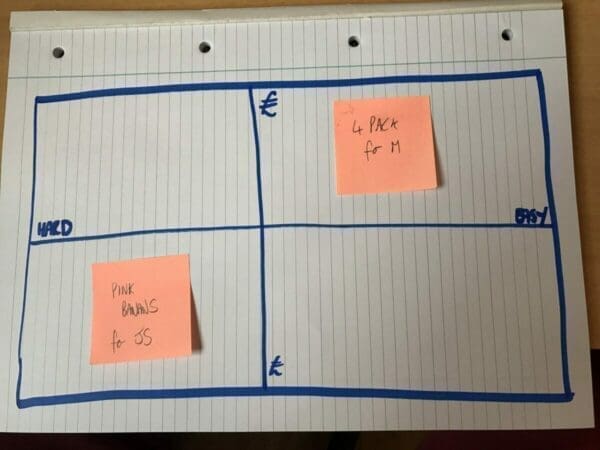Don’t Forget to Plan to Negotiate
No.3: Prepare to Sell, But Don’t Forget to Plan to Negotiate
No is Bad, Yes is Good…. But
‘No!’ – the one, tiny word guaranteed to strike terror into the very heart of any account manager. Buyers are there to do deals – it’s their job title after all! – You may not think it, but they really don’t like to say ‘no’ too often. Saying ‘no’ too regularly can lead to missed opportunities and investments which can then be subsequently taken up by their competitors. Even worse and often terminally career limiting, the result of too many ‘nos’ too often can be empty shelves – so plan to negotiate!
They much prefer therefore to say ‘yes…but’ quickly followed by trotting out one of the oldest tactics in the buying book. The venerable ‘Oliver Twist’ tactic of saying ‘Yes, but……. I want more!’
Negotiation is Good
We have spent the last two articles in this series examining some of the common mistakes sales people make when meeting with and selling to buyers. In this article, we are going to focus on the natural outcome of a successful sell. But one that account managers (in my experience) spend far too little time thinking about and preparing for – Negotiation.
Negotiation is only possible if you have successfully sold. That is you have convinced the buyer that your proposition or plan meets at least one if not more of his or her shopper, business or personal needs.
So, when a buyer asks you for ‘more’ you should vigorously shake their hand and profusely thank them! They are signalling that you have successfully sold and now it is simply a matter of negotiating the final deal.
A Game of Two Halves
So do prepare great, needs meeting, selling stories. But do not forget to spend at least as much time planning how you will plan to negotiate a mutually profitable deal following on from your successful prepare to sell.
At Making Business Matter I meet and see many hundreds if not thousands of account managers each year at our workshops and courses. Too often I see fantastic and superbly prepared selling decks in all their PowerPoint glory. But rarely see a well thought through, formally laid out, costed negotiation plan with clear tradeables, positions, options and fallbacks.
Our advice is that you spend at least as much time planning your negotiations as you do in preparing your selling stories, decks and presentations. Think of it as a game of two (equal) halves if you like. You don’t want to play a blinder in the first half, get ahead of the game only to find yourself comprehensively outplayed, outgunned and inevitably beaten in a frantic second half of negotiation.

You Can Never Have too Many Tradeables
Tradeables are the ‘oil’ of any negotiation – they allow any potential conversation to flow smoothly, giving both sides that classic and much sought after but often not achieved ‘Win-Win’ outcome. However, in my experience, too often account managers fail to go beyond thinking of and planning the most obvious tradeables – those intrinsically close to the deal such as cost price, store distribution numbers, number of facings and shelf positioning.
You should never enter a negotiation following a successful sell with a supermarket buyer without planning and arming yourself with at least 20 if not closer to 50 tradeables that you can use to efficiently and effectively ‘oil’ the negotiation process.
Trade High Value and Low Cost
You are looking to identify those High Value to you but Low Cost for them to give tradeables and vice versa – those Low Cost for you to offer but of High perceived value to them tradeables.
So where to look? Well buyers are constantly under pressure to deliver for their respective businesses over and above their core KPI’s of sales, cash margin and market share.
They are constantly being harangued by different departments within their own business for support and investment from their suppliers. Buyers see these ‘requests’ – voucher funding, shopper leaflet investment, instore sampling demonstrations, prizes for shopper competitions etc. etc. etc. as like a never ending row of ‘monkeys’ on their shoulders. A long line of tiresome, time consuming and (to them) non critical to their day job, mini hassles to be agreed and negotiated.
These are the tradeables to identify. Buyers will often be willing to trade these for less than their true value to you just to get a tiresome, jabbering ‘monkey’ off their seemingly endless, incessant ‘to get’ list.
Find Your Tradeables in Store
You will find these tradeables by spending a good morning or afternoon walking one of their larger stores.
Don’t just visit as you would normally the aisle stocking the category you happen to supply. Additionally walk all the ‘big’ category aisles with lots of marketing activity going on. Beers, Wines & Spirits, Frozen Foods, Soap Powder, Cereals, Hot Beverages, Fruit & Veg, Meat. Take careful note of all the ‘stuff’ that is going on. POS, barker cards, shelf wobblers, floor stickers, hanging boards, category signage, category fins, header boards, feature space, new line space, the list is almost endless.

Additionally, also look at all the other activity going on in and around the store – advertising on trolley handles, checkout queue dividers, till roll advertising, instore radio, instore TV, petrol station hoardings, car park hoardings etc. etc. etc.
All of these are tradeables that you can use as the oil to efficiently plan your negotiation. Yes, there may indeed be a rate card ‘gate fee’ attached to them. But often you will be able to get more bang for your gate fee buck. Or negotiate the gate fee down if you are helping a hassled, harried, time poor buyer lose a few of those monkeys lining up along their shoulders. Not only will you get a great deal. You will build a much more effective rapport and relationship with a very grateful buyer!
Buyers are There to Buy!
Buyers love doing deals – it is in their job title after all!
Often a big intractable, problematic negotiation with both sides seemingly entrenched in their respective positions can be freed up by introducing new additional and often unrelated tradeables into the negotiation.
Just as in big political and military stand offs, it is often the smallest of deals that helps to melt the ice and break the log jam of impasse. Thereby allowing the bigger deal to progress.
Plan to Negotiate – Multiple Negotiations
This is also true when selling and negotiating at more senior levels and with complex multi-level negotiations where you may not be able to agree what you want with the buyer. Because they don’t necessarily have the authority or permission to say ‘yes’.
It is very rare these days that you will ever get agreement from a buyer at a single meeting. There is the selling presentation itself, inevitably followed by numerous follow up emails and telephone calls. Before (if you are lucky) a final confirmatory meeting or notification. Remember each of these interactions is the opportunity for buyers to negotiate further. Often utilising the ‘agreement by downgrade’ or more memorably known as the ‘death by a thousand cuts’ tactic! You need to be equipped and armed with plenty of smaller, easy to transact tradeables for each of these small steps towards the end game of the negotiation.
How Long and How Far up the ‘Tree’ Will the Chess Game Go?
For bigger, more complex, multi-level negotiations think of the process as a big game of chess. You need to ensure you look ahead in your planning. Try to predict just how many ‘chess moves’ there will be in the negotiation you are entering.

Ask yourself. Is it a relatively straightforward, simple one or two meeting step new line listing negotiation or is a complex cross category, multi sku, multi mechanic, annual trading plan negotiation with the added fun of a price increase?!
If so, you need to plan for at least a 3 to 5 meeting chess game negotiation. With each step potentially escalating up the supermarket’s commercial hierarchy at each step.
A simple, super handy rule of thumb. If the deal or sell you are trying to get agreement for accounts for 10% or more of your buyers category sales. Then there is a very high probability that your buyer will have to involve his or her boss in the final negotiation and/or decision. The same 10% ‘rule’ applies to the buyer’s boss and the value of their total category remit and so on up the commercial hierarchy to board level should you be ‘fortunate’ enough to enjoy sales that account for 10% of your customers turnover!
Probability of Negotiation
So, calculate the probability of and how far your proposal will have to travel up the commercial hierarchy. Plan your negotiation tradeables accordingly.
You need to have enough tradeables to last through to the very last meeting and ensure that you keep some of the best. Those that are of the highest perceived value to either side – up your sleeve for that final sealing of the deal moment.
Remember senior executives and believe me especially senior buyers, category directors, trading directors and commercial directors like to be seen to be wearing the ‘Superman’ underpants. To show their underlings ‘how it’s done’. As they heroically step in and smoothly bring the negotiation to a successful and beneficial close!
So always ensure you plan carefully which tradeable to introduce and when. As the chess game progresses, and leave sufficient and sufficiently (perceived) valuable tradeables for the last stages of the negotiation.
Get into the Habit of Regularly Refreshing Your Tradeables
You can never have too many tradeables in your negotiation toolbox. Always have a running list of at least 20 and preferably something nearer 50.
Spend a good day with the wider account team to brainstorm and generate as many tradeables for both sides as possible. Remember to think for both ‘sides’ – those you can offer and those you want back in return.
A simple Boston High/Low matrix on big sheets of paper with Post Its is a very interactive, practical way of getting the team thinking and working together to generate tradeable ideas.

Once generated, costed and valued keep them fresh and refreshed regularly integrating them into account discussions and planning.
More Yes’s, Fewer No’s …. I Want More…. Less
The most successful account managers spend at least as much time planning to negotiate as they normally would preparing their selling decks and stories. Get into the habit of allocating a 50/50 balance to your selling and negotiation preparation and planning time.
Remember to profusely thank your buyers as and when they ask for more. They are after all signaling that you have been successful in your sell. They can see in their minds eye your idea or proposition on their shelves. It’s simply a question of how you now effectively negotiate a mutually beneficial deal to get your idea across the line and into their stores.
Action: For even more useful content on negotiations, check out our ultimate guide on negotiation skills.
Good Luck!



